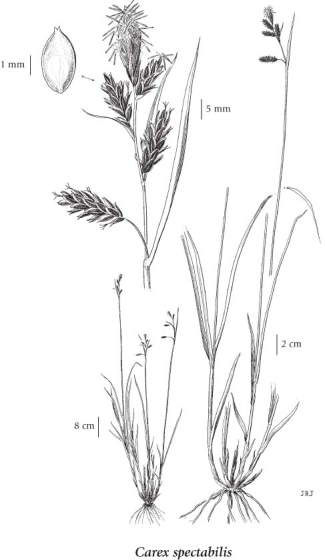Carex spectabilis Dewey
showy sedge
Cyperaceae (Sedge family)
Introduction to Vascular Plants
showy sedge
Cyperaceae (Sedge family)
Introduction to Vascular Plants
Species Information
General:
Perennial, tufted herb from short, stout rhizomes; stems 15-60 cm tall, exceeding the leaves.
Leaves:
Sheaths purplish-red towards the bases; blades flat, 2-6 mm wide, the lower ones much reduced.
Flowers:
Spikes 3 to 9, the terminal one with male flowers, the lower spikes 2 to 8, with female flowers, 1.5-3.5 cm long, short-stalked, erect, except the lowermost often long-stalked and nodding; bracts subtending the spikes sheathless, bristlelike, and shorter than the inflorescence, or leaflike and longer than the inflorescence.
Fruits:
Perigynia egg-shaped, 2.5-3.5 mm long, 1.2-1.8 mm wide, yellow-green, or brown to purple-black, nerveless or faintly nerved, the beaks short, 0.3-0.5 mm long; female scales lanceolate, nearly as long as and narrower than the perigynia, pointed at the tips and extended into short awns, reddish-black, with light brown margins; stigmas 3; achenes 3-angled, egg-shaped, 1.4-1.7 mm long.
Notes:
Sometimes difficult to separate from C. podocarpa in NW BC.
Illustration

If more than one illustration is available for a species (e.g., separate illustrations were provided for two subspecies) then links to the separate images will be provided below. Note that individual subspecies or varietal illustrations are not always available.
Illustration Source: The Illustrated Flora of British Columbia
Ecology
Ecological Framework for Carex spectabilis
The table below shows the species-specific information calculated from
original data (BEC database) provided by the BC Ministry of Forests and Range.
(Updated August, 2013)
The table below shows the species-specific information calculated from
original data (BEC database) provided by the BC Ministry of Forests and Range.
(Updated August, 2013)
| Site Information |
Value / Class |
||
|
Avg |
Min |
Max |
|
| Elevation
(metres) |
1917 | 620 | 2520 |
| Slope
Gradient (%) |
27 | 0 | 119 |
|
Aspect (degrees) |
185 | 0 | 360 |
| Soil
Moisture Regime (SMR) [0 - very xeric; 4 - mesic; 8 - hydric] |
3 | 0 | 8 |
| Modal
Nutrient Regime
Class |
C | ||
| #
of field plots species was recorded in: |
1024 | ||
| Modal
BEC Zone Class |
ESSF | ||
|
All BEC Zones (# of stations/zone) species was recorded in |
AT(98), BAFA(6), BWBS(2), CMA(45), CWH(1), ESSF(694), ICH(14), IDF(3), IMA(82), MH(39), MS(1), SBPS(2) | ||
|
Source:
Klinkenberg 2013
|
|||
Habitat and Range
Moist to mesic meadows and forest openings in the montane to alpine zones; common in S BC, less frequent in C and NW BC; N to AK and YT, E to SW AB and S to CO, UT and CA.Status Information
Synonyms
Synonyms and Alternate Names:
Carex invisa L.H. Bailey
Carex nigella Boott
Carex tolmiei Boott